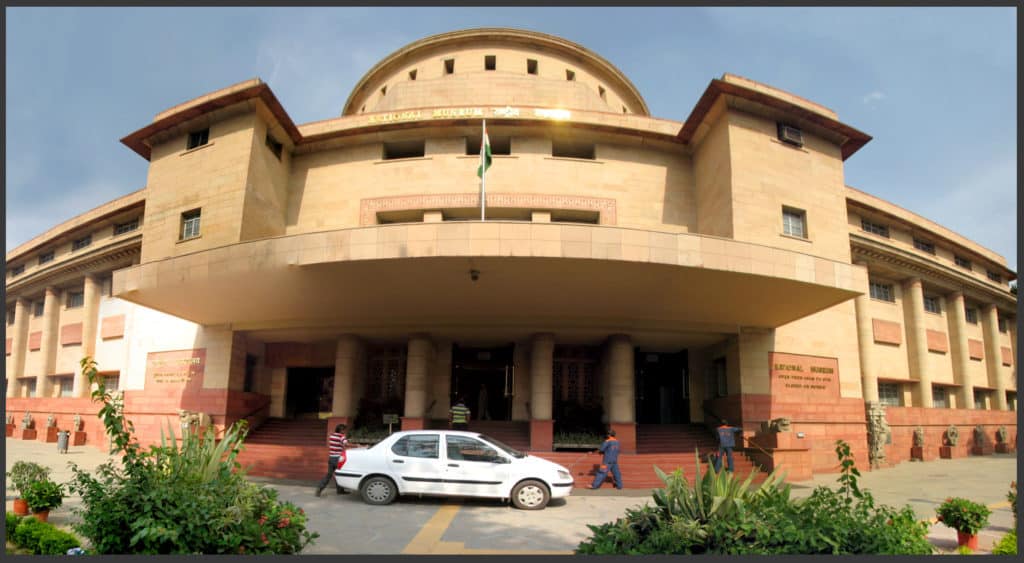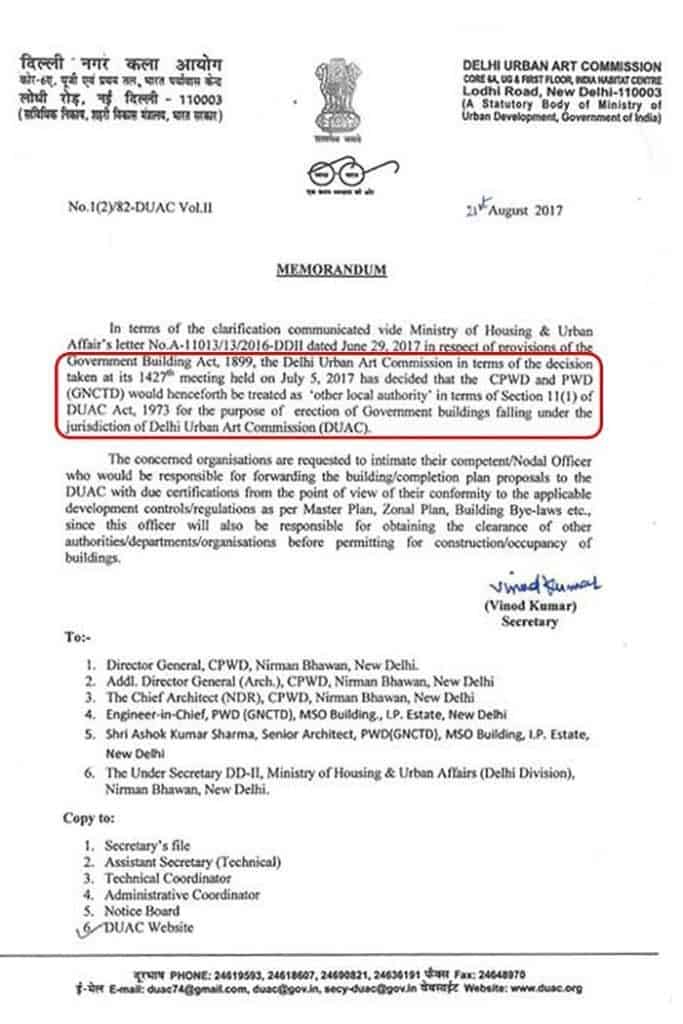For opaqueness and unsolved mysteries, no other government project comes close to the Central Vista Redevelopment Project (CV) currently underway. The strong push, particularly from the prime minister, for timely completion of the new parliament building before his second term expires, is resulting in brazen violation of building laws as mentioned in the Delhi Master Plan (MPD).
The over Rs 20,000 crore project will witness the construction of a triangular-shaped new parliament, new residences for the prime minister and vice-president, a new central secretariat building and demolition of existing buildings along Rajpath. These include some which are just 10 years old, like Jawahar Bhavan, which houses the external affairs ministry and is considered a state-of-the-art architectural structure, built at a cost of Rs 220 crore and commissioned in 2011.
The other buildings include the Indira Gandhi National Centre for the Arts, Shastri Bhawan, Vigyan Bhawan, Krishi Bhawan, the vice-president’s current residence; National Museum, Nirman Bhawan, Udyog Bhawan, Raksha Bhawan, the Annexe Building of National Archives and 7 Race Course Road, the prime minister’s current residence.
A total of 4,58,820 square metres of the total built-up area will be demolished for the project.
Controversies galore
The Central Vista redevelopment project has been intensely controversial right from the start. Over the proposed demolition of heritage structures, over the need for such huge spending for a new parliament when a fully functioning parliament building already exists, over violation of building bylaws, loss of green cover, fudging of the environment impact assessment (EIA) and the loss of existing, large open public spaces.
Also, the use of Quality and Cost Based Selection (QCBS) system of bidding, which is considered appropriate for bidding tenders for civil works, cannot be considered a prudent way of deciding the design of the new parliament building. The other pertinent questions are over the opaqueness surrounding the bidding process and selection of the final winner which did not allow a fair play of creativity to explore new ideas.
Read more: Opinion: Amendment to law on Delhi governance retrograde and regressive
The most vocal and vociferous objections were on the violation of rules and procedures which included land-use change and heritage protection. But the project got the green signal from the Supreme Court with a 2-1 verdict. However, the dissenting judge categorically stated that the project is illegal in the eyes of law.
As work on the project picked up pace, even as the pandemic ran amok in the country, opposition parties and prominent individuals from different sections demanded that the money being spent on the project should be utilised instead for meeting the health crisis the country was going through.
But the government termed the Central Vista an essential project and work on it went on even as most parts of the country, including Delhi, were under strict lockdown. A petition filed at the Delhi High Court sought orders for the work to be halted, to at least protect the lives of the workers on the site. But the court rejected that and work was allowed to continue.
Despite winning the legal battles, however, the government continues to face criticism, with several sections of the media highlighting the unfairness of this project during the pandemic. In response, the government issued two statements. The first by the Ministry of Housing and Urban Affairs to a write up in a web portal, terming the Central Vista redevelopment project as a waste of money. The other was by the minister himself to a letter from a group of retired bureaucrats asking the government to withdraw this project. Defending the project, the minister said those who signed the letter are ‘padhe likhe gawar’ (educated illiterate) and a “disgrace to the nation”.
The Vaastu connection
But there is more to all this. Romi Khosla, one of the country’s pioneering architects, in an interaction with this writer said that the driving force of this government is sheer ideological obscurantism. Some architects who believe in Vaastu Shastra seemed to have convinced the powers that be that unless the BJP government shifts from the round-shaped parliament, which is considered inauspicious for them, they will not be able to win the 2024 elections. Hence the rush to complete the parliament building by 2023. The genesis of this argument lies in a dialogue between the then Lok Sabha Speaker Manohar Joshi (2002-2004), and this group of Vaastu proponents.
The second important issue that needs to be framed here before going into some concrete revelations is that the present Modi government does not believe in the modernism of Nehru and his buildings, and the relationship between people vis-a-vis the government. The open spaces around Rajpath were important for people to assemble not just to picnic but also to have a feel of the governance, as pointed out by artist Vivan Sudaraman and architect Prem Chandavarkar.
Also read: To develop a city for transit, or transit for a city?
This relationship between people and the government must change and make way for a ‘ruler-ruled’ relationship, according to the BJP’s ideology. These new central secretariat buildings that are being planned are to showcase the strength of the government and people’s inaccessibility to them.
Other issues
Massive public space being usurped: According to the EIA submission, at six places land-use change is proposed from public and semi-public facilities to government offices. The new parliament building is coming up at a designated district park. Nearly 120 acres of public open spaces is being taken over for government buildings in complete violation of the Delhi Master Plan (MPD) rules, according to which land designated as open spaces or parks cannot be converted to any other use.
CPWD becomes a local body: The prevailing laws across the country say approval of building plans has to be done by a local body. In the central vista redevelopment project, all the land comes under the New Delhi Municipal Council (NDMC), which is not elected but has 13 members, some of whom are elected legislators and a few are nominated by the Delhi chief minister. Rest are bureaucrats. In this case, it is the NDMC that should have approved the plans. But the Centre converted the Central Public Works Department (CPWD), which is the development and construction arm of the government, into the local body, and got the project sanctioned. Even the Delhi Urban Arts Commission (DUAC) which approved the drawings is not authorised to give such permission. So the CPWD sanction is not legal.
A Transit Oriented Development (TOD) project: This is something very recent. A Transit Oriented Development project should have 30% per cent of the total area it covers as residential. It is a capitalist developmental model where people live near the metros and mainly use public transport for their mobility.
Interestingly, the government of India in its affidavit in the Supreme Court specifically mentioned that this is not a TOD project. But the principal architect of the project has been saying that it is an evolving project, and the ministry of housing in its reply to the web portal said that it is a TOD project, and is a part of the project’s guiding principles.
According to the MPD, Chapter 12 allows monetisation of 10% of the total project area. Is this then one of the guiding principles, where some of this central vista land will be sold to corporates? The government needs to clarify.
Huge space for ministers and bureaucrats: As stated above, nearly 4.5 lakh square metre of built-up area will be demolished but nearly 16.5 lakh square metre area will be newly constructed. This converts to a per capita availability of nearly 195 square feet of built-up space. Nearly 85 per cent of the secretariat workforce is Group III and IV who occupy less than 60 square feet per person. But ministers will get more than 3000 square feet per person. The proposal envisages yoga and music rooms in these buildings. Plus nearly 260 conference rooms with a capacity of 50 seats each.
Playing with the Floor Area Ratio (FAR): Floor area ratio determines the space that a building can provide. Here, the FAR has been raised from 120 to 200, and is one of the reasons for terming it as a TOD as under this model the project can get a higher FAR.
Cutting down trees: For the first time, instead of the developer, in this case the CPWD, saying that a certain number of trees have to be cut or transplanted, the CPWD instead asked the contract beneficiary to specify this number. According to the EIA and EMP reports, 3,750 trees are either to be cut or transplanted, leading to a huge loss of both open and green spaces.
The central vista project thus undermines the relevance of building laws, environment, heritage and a host of other rules. As it evolves, as the constructing architect said, we are bound to get many more surprises. But the real tragedy is that the government and legislator, the maker and executor of these laws, is itself violating the law.


Indepth analysis of the problematic points.
Very accessibly written. Is this available in Hindi ? It is imperative that Hindi speakers be addressed, else the ‘debate’ is seen only in political terms.